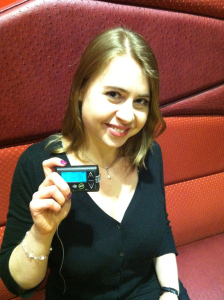My Continuous Glucose Monitor
 What is the Continuous Glucose Monitor? Initially, I was pretty skeptical.
What is the Continuous Glucose Monitor? Initially, I was pretty skeptical.
I like my freedom. I’ve never been big on commitments. I already had an insulin pump attached to me 24/7. Why constrain my life with yet another medical device?
But I couldn’t stop thinking about it. Continuous glucose monitoring… It sounded so informative, so useful.
At the time, I wastesting my blood sugar over ten times a day, and once or twice during the night. But I still felt that there were large gaps in the data. I finally had to admit: This new device was kind of intriguing. So…
I did some research. I learned that the Continuous Glucose Monitor (CGM) system has several different components, including the sensor, the transmitter, and the insulin pump. The sensor has a cannula (a small tube, about one centimeter long) that gets inserted into the skin. The sensor is the part that is continuously reading glucose levels. The transmitter gets attached to the sensor. It’s the size of a soda bottle cap, just a little wider and flatter. The transmitter is the part that sends a new glucose reading to the insulin pump every few minutes. The pump then displays these continuous readings.
I decided to give it a trial run. Logistically, it took some time to adjust. And I had to learn the systems. But within a few months, I was sold!
The CGM allows me to keep better control of my diabetes. It’s constantly updating my most recent glucose reading. It shows when my blood sugar is going up or down too fast. It alerts me if it’s out of range. It displays graphs of my glucose levels over time.
And despite my initial reservations, it actually gives me more freedom than I’ve ever had!Here are some highlights of my life with the CGM:
I know when to eat. Insulin can take anywhere from 10 to 60 minutes to start affecting my blood sugar. The CGM helps me get the timing right. By watching the graph closely, I can ensure that the food and insulin are working at the same time to balance each other out. My post-meal glucose levels are so much more stable now!
I can see where my blood sugar’s been. The CGM graphs are dreamy! As a person with type 1 diabetes, I highly value thiskind of real-time information. The 3-hour graph shows the immediate effects of food, activities, insulin, etc.. The 6-hour and 12-hour graphs keep me in tune with how my day has been so far, and help to predict what my glucose levels will do in the next few hours. The 24-hour graph is great for reviewing a full day/night cycle and adjusting pump settings accordingly.
I have more information and can adjust settings with better precision. TheCGM 24-hour graph helps me identify glucose patterns and make adjustments to help stay in better control. For example, while reviewing this graph one morning, I noticed my blood sugar had started dropping while I had been asleep. Over the next few days, I saw this happen again around the same time. Once I was sure this was not due to a lingering bolus, I felt confident changing my basal rate. Pretty soon, the graphs showed smooth sailing through the night!
I don’t overdose a low blood sugar. If I ever begin to notice a rapid drop in my 3-hour graph, I’m ready for it. I monitor carefully and listen for the “low” alarm. When treating a low, I’ve discovered that a little sugar goes a long way.I test my blood, take two glucose tablets, and allow my glucose to stabilize slowly. Inmy pre-CGM days, I always aimed to get my blood sugar back up really quick, and had a tendency to overdose.My blood sugar would often shoot up too high, and would result in a roller coaster of spikes and drops. With my CGM, I can keep my glucose levels more stable by treating lows more gently.
The CGM is relatively discreet…Most of the time, the sensor and pump aren’t noticeable. They tend to be concealed under my clothes. But I’m honestly such a fan of the CGM, that it doesn’t bother me when people do notice. “No, it isn’t a pager,” I smile when people ask. And I’m eager to explain: “It’s actually a medical device. For diabetes.” I enjoy these opportunities to talk about all the ways the CGM has improved my life!
Please share! I’m so curious to hear other peoples’ experiences with continuous glucose monitoring systems! Do you use a CGM? What kind? What are some highlights of your life with the CGM? Are you considering a CGM? What would you like to learn about it?
Please write a comment below!
For more information about my CGM, check the Medtronic website: http://www.medtronicdiabetes.com/treatment-and-products/continuous-glucose-monitoring
